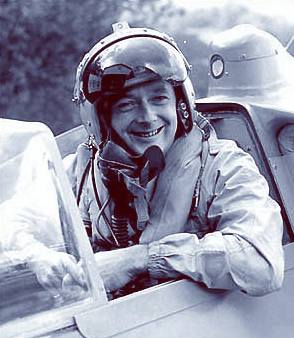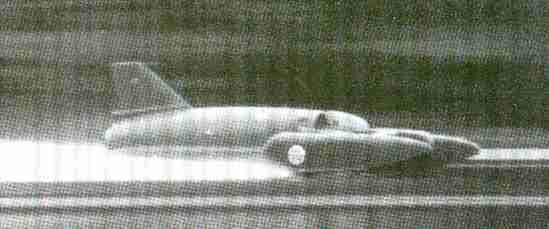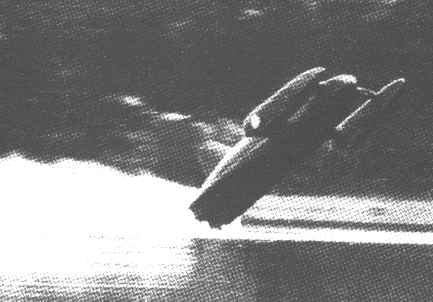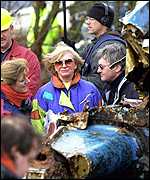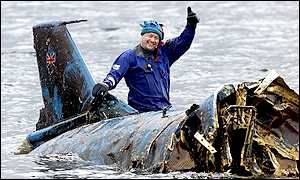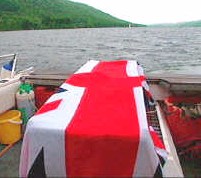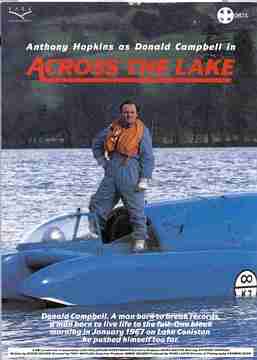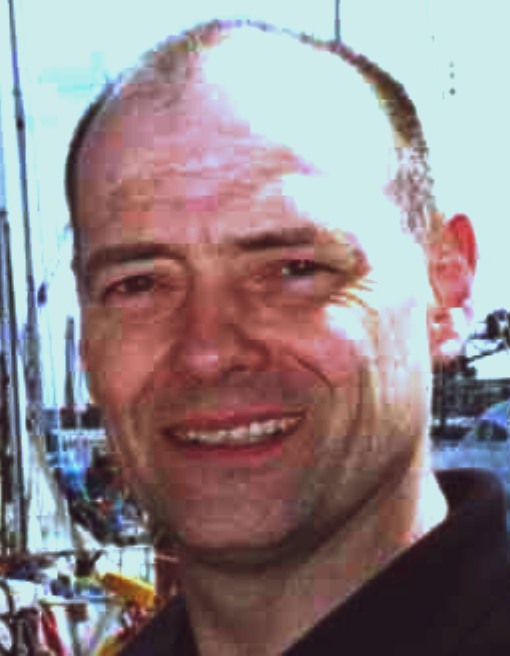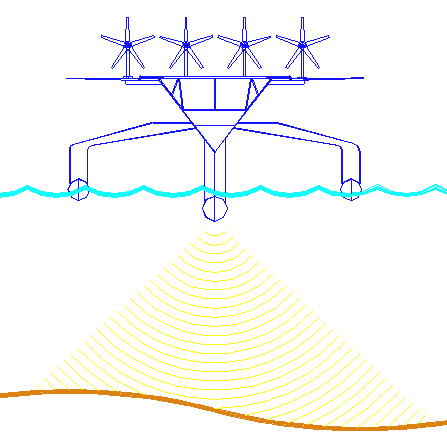|
DONALD CAMPBELL and KEN NORRIS'S K7
|
|||
|
Donald Campbell inherited Sir Malcolm's taste for adventure, plus of course a Bluebird boat to start him on the trail to a LSR and WSR career, purchased for a nominal fee, after Sir Malcolm passed away in 1948. The K4 was converted from propeller drive to jet engine, but Major Halford from de Havilland was disinclined to to see Donald use it because of his inexperience. Accordingly, he asked for it to be returned. Hene Vospers were asked to convert it back to propeller drive, which pleased Leo Villa. All that remained was to fit the Rolls Royce engine, then on 10th August, Donald made four runs and later in the week experienced a scary moment or two but nevertheless did not let up.
Donald Campbell
Reid Railton brought it to the attention of the team that Stanley Sayers boat used a special propeller that enabled the boat to lift out of the water - a prop rider. Reid Railton had seen K4 in action and noticed it rise a the rear, causing the nose to point down into the water. After this Donald wanted to convert the boat to a full-blown prop rider. Lewis and Ken Norris were commissioned to do the design work. The engine was moved forward to alter the centre of gravity, and the seat was relocated on the port side. A new propeller was also specified.
During this conversion Donald was invited to enter the Oltranza Cup, an Italian event. The race took part on Lake Garda. This was four laps over a 5-mile triangular course; with the winner winning the Grand Prix for the fastest overall speed and the Oltranza cup going to the boat that set the fastest time over two consecutive laps.
The race took place on the 10th of June after being delayed due to bad weather. After failing to start the engine, the ywere forced to change all 24 spark plugs. Because of this they had no chance of winning the Grand Prix. They could however still win the Oltranza cup. Leo Villa accompanied Donald for a rather exciting ride. The K4 took a bit of a pounding smashing many instruments. The ride was sufficient to draw a few choice words from Leo as to Donald's performance. However they won the Oltranza cup by a convincing margin. This win did wonders for Donald's recognition for his skills as a driver. So began Donald's career in fast boats.
Donald suffered a 170Mph crash in 1951. As a result of this crash he developed a completely new boat, the K7, after enlisting the services of a brilliant designer Ken Norris. Ken had earlier worked on the ill fated White Hawk K5 jet hydrofoil boat. The resulting K7 was to prove a formidable steed that saw him set 7 World Water-Speed records between 1955 and 1964. The first was at Lake Ullswater where he set a record of 202Mph. This was raised to 216mph at Lake Mead in 1955. Then began a sequence of record raising runs at Coniston where he attained 248mph in 1958. But to really push out the boat record wise he went to Lake Dumbleyung, Australia, where the K7 set a new world records of 276mph in 1964.
The K7 first run 4 January 1967
Donald's career spanned 18 years and finally end in tragedy on Lake Coniston, where he was trying to best his own record to drum up sponsor interest. In addition, there was a prize for each time the water speed record was broken, which it is believed the speedster benefited from during his 12 year career on water. This tragedy was later made into a film to commemorate the great man starring Anthony Hopkins as Donald Campbell, named 'Across the Lake'. Unfortunately for many enthusiastic about the BBC docudrama, the film is not on general release.
A heavier, more powerful gas turbine engine was fitted to K7 and the position changed so as to correct the boats trim. Donald had overspent keeping his crew on while waiting for a break in the weather. Determined to give the Press a show to make their wait worthwhile, at around 8:30am Donald clambered into his boat. An army of photographers had been camped by Lake Conniston waiting for something to happen and this was it. To the amazement of all gathered to record the event and with shutters clicking for all they were worth, the K7 gracefully took to the air, somersaulted and nose dived into the lake. There was a stunned silence for quite a time before somebody reported over the radio: "There's been a complete accident. No details. Over." Although the wreck was not recovered, the K7's insurers made an ex-gratia payment to the estate of Donald Campbell against this total loss.
He was travelling at more than 300mph (483 km/h) on Coniston Water when the boat was catapulted 50ft (15m) into the air after its nose lifted. Forty-six-year-old Mr Campbell was killed instantly as the boat hit the water and immediately disintegrated. He was just 200 yards (183m) from the end of the second leg of his attempt when the accident happened. This sequence is almost identical to an incident involving Slo-mo-shun in 1950. Indeed, John Cobb was to suffer a fatal crash in his jet propelled hydrofoil boat, Crusader.
K7 crash, Donald Campbell - Youtube
After a swig of coffee laced with brandy, Donald Campbell slid into the cockpit of Bluebird K-7, his lapis blue colored hydroplane, gave a thumbs-up, and ignited the 4,000-pound-thrust jet engine. Since 1955, he and Bluebird had cheated death to break the water speed record seven times. When he captured the land speed title in 1964, Campbell became only the second person besides his father, Sir Malcolm, to hold both records. Throughout the United Kingdom, the Campbells were legendary and the Bluebird an icon.
There wasn't a hint of wind as Donald Campbell throttled to the other end of the mirror smooth lake. Within seconds, he'd raced through the measured kilometer, at 297 mph. "Full house!" he radioed. Campbell had just gone 21 mph faster than anyone had ever gone before, putting him in a place where the effects of air and water on a boat were a mystery. But to establish a record sanctioned by the UIM (Union Internationale Motonautique) the powerboat governing body, requires two runs through the trap in opposite directions within an hour. Impatiently, Campbell started his second pass driving into the ripples left by his own wake. At 200 mph, his eyeballs began oscillating as he hammered across Coniston water. "I can't see much, and the water is very bad," he said. At around 300 mph, Campbell felt like he was riding a turbine-powered vibrator. "I can't see anything I'm having to draw back [on the throttle]." Suddenly, Bluebird lifted off the lake. "I've got the bows up!" he said. "I've gone... oh... "
On the first leg he had reached speeds of 297mph (478km/h), which meant he had to top 308mph (496km/h) on the return journey. Initial reports suggest he had actually reached speeds of up to 320mph (515km/h). This means the water speed record of 276.33mph (444.61km/h), which Campbell himself set in Australia in 1964, remains unbroken as both legs of the attempt were not completed. Had he broken this barrier it would have been his eighth world water speed record.
Bluebird K7 crash 4 January 1967
Thirty-four years later a salvage operation led by Bill Smith, finally raised the wreck of the K7 to the surface of the lake. Tonia Bern-Campbell witnessed the landing of the craft. Donald's body had not been located by this time, but the search continued apace and with the aid of modern sonar equipment, Donald's body was also recovered two months later in May 0f 2001 and laid to rest. May he rest in peace.
The salvage operation started in December 2000 when divers testing underwater cameras came on the wreckage. Underwater surveyor, Bill Smith found the wreck at 150 feet half buried in silt. Donald Campbell’s body was never found at the time of the tragedy. In March 2001 Bluebird was recovered from the lake bed . Campbell's widow Tonie Bern Campbell, 64 watched it emerge from the lake. The tail was undamaged but the front cockpit area was completely crushed.
The Coniston Institute and Ruskin Museum Charitable Trust now want to provide a permanent home for the remains of Bluebird and are seeking permission for a 10m by 10m extension to the Museum to house it. The application is supported by a letter from the Curator of the museum stating that Bluebird is part of Coniston’s heritage and the people of Coniston "believe most strongly" that the craft belongs in the town as a "permanent memorial to a great British hero".
Donald Campbell 16th November 1955 - Youtube
The funeral service at Coniston Parish Churchyard took place in September 2001. Donald Campbell has finally been given a permanent headstone on the edge of Coniston Water 35 years after his death. Family, friends and those involved in the salvage of the record-breaking Bluebird, were present at the moving service in St Andrew's Church, Coniston.
“Bluebird” has been in storage in the northeast since she was raised from the bed of Coniston Water in March 2001 by a team of divers led by Bill Smith of Newcastle. Now Lake District planners have approved plans to extend the village’s Ruskin Museum to house the boat in a permanent exhibition celebrating the record-breaking achievements of Donald Campbell and his father, Malcolm. Applicants the Coniston Institute and Ruskin Museum Charitable Trust have been granted permission to build a 33ft by 33ft extension to the museum
The K7 wreckage recovered 8 March 2001
One of the most controversial acts to have taken place at Coniston in recent years was the raising of Bluebird from the lake bed during the spring of 2001. It is probably fair to say that the majority of those born and bred in the village were against any form of salvage. The general opinion was that the wreck should be left where it had been lying for the previous 34 years.
Salvage operations started with the assembly of two large barges on the car park of the Bluebird Café at the lake shore. Once completed the barges became a floating platform which could hold the lifting crane and the mass of underwater equipment needed for the salvage operation to proceed. The platform was launched on March 2nd, towed out to a point above the wreck and secured with ropes to concrete blocks which had been placed on the lake bed.
Next day, with the assistance of a remote operating vessel, divers started to secure lifting lines to the wreck. Once complete the delicate operation was started to lift the craft clear of the thick glutinous mud on the lake bed, without causing any further damage. This took several days and was completed on March 7th with the help of hydraulic lifting bags. By the close of play that day Bluebird had been raised from the lake bed and was hanging from the floating platform, just below the lake surface, by its lifting lines.
Tonia Berne Bill Smith raises the K7
K7 crashes killing Donald Campbell at Coniston - Youtube
Soon after the body was located it was recovered with great dignity and with the full co-operation of the coroner and police. A casket was lowered onto the lake bed and the remains were placed in it. On Bank Holiday Monday the casket was lifted onto the team's boat and covered with the union flag. It was then brought to Pier Cottage. While still out on the lake a short impromptu service was carried out by the salvage team as they waited for the coroner to arrive.
Donald Campbells body
On
the 28th May 2001 A body was recoverd from Coniston
Water by the Bluebird Project Team. Gina
Campbell,
Donalds Daughter asked if the team could locate and
recover her fathers body. There seems no doubt that
the body is that of Donald Campbell. DNA tests are
being carried out to confirm this.
Body in lake is Campbell Friday, 10 August, 2001
A coroner has confirmed that human remains found in Coniston Water are those of powerboating legend Donald Campbell. An inquest heard tests on DNA samples taken from the body and from members of Campbell's family proved the remains were 1.9 million times more likely to be those of the speed hero's than anyone else.
Campbell was trying to break his own water speed record of 276mph when his boat somersaulted before crashing. Divers found the remains in May - 34 years after Campbell's attempt ended in his death. Furness coroner Ian Smith said there was "absolutely no doubt" the body was that of Donald Campbell. After the hearing in Barrow Town Hall, Cumbria, Campbell's daughter Gina, 51, said she felt "totally relieved". She said: "There was always a little bit of doubt. Now there is no doubt. "The mystery of the lake now becomes a reality."
Anthony Hopkins plays Donald Campbell
Donald Campbell CBE
23 March 1921 - 4 January 1967
"Of records and record breakers, I would remind you that speed is relative to time. What we consider slow now, was unthinkable in years gone by. However, each time a contender goes out onto the field of battle, he or she faces the same hurdles, the same fears and financial challenges as those before us, and most importantly of all, has to muster themselves to boiling point make it all happen. In the end, players will either triumph or fail, but in doing so, show others where to, and where not to tread. All too often players pay the ultimate price. Whether they raise Man's technical mastery up another notch or not, history should remember every last one of them - for they were players." (Nelson K December 2005)
LINKS :
Hydroplanes and Racing:
Hydrofest
|
|||
|
This website is Copyright © 1999 & 2012 Max Energy Limited, an environmental educational charity working hard for world peace. The names Solar Navigator™,Blueplanet Ecostar BE3™ and Utopia Tristar™ are trademarks. All other trademarks are hereby acknowledged.
|
